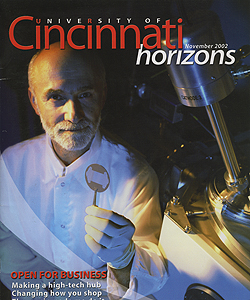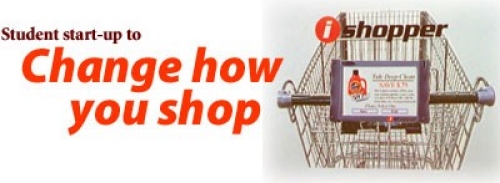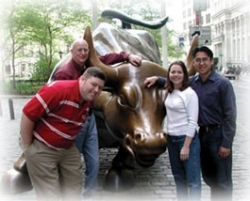by John Bach
Paolo Dominguez could be the poster boy for entrepreneurial thinking. He envisions the day when grocery shoppers will navigate the cereal aisle, while a discount ad for Honeycomb or Raisin Bran automatically appears on a cart-mounted touch-screen display. The same display will help consumers avoid the arduous search for hard-to-find products with a simple store map. Dominguez would prefer to let the technology determine if olive oil is shelved with the salad dressings or the baking goods: Aisle 18, midway down, top shelf.
He also sees no reason to stand in long checkout lines to rehandle all those groceries. The interactive unit will allow you to scan your groceries as you fill your cart and stop only to pay your total, minus the digital coupons.
Just a year ago, Dominguez, Bill Kinnaird and Mike Ross were classmates at UC fleshing out their idea for a business plan in their New Ventures class at the College of Business. Today they are founding partners of Interactive Shopping Experience Technologies, a venture company they hope will revolutionize the retail industry. For now, however, iSE-Tek exists only on paper. It hasn’t earned a penny. According to the business model, it will achieve millions -- even at the rate of a few pennies at a time.
An outlandish-sounding financial prediction rolls off Dominguez' tongue like a trivial fact. "We are projecting $500 million in revenue within three years," the 29-year-old MBA grad says without hesitation.
The centerpiece of iSE-Tek is the i-Shopper, a touch-screen display that attaches to a shopping cart. The technology delivers targeted advertisements to consumers as they make their way through a store or at the "point of decision." And each time an ad appears, iSE-Tek banks a few cents.
"If you walk into a grocery store today, it seems like it is asking for a technological solution," Dominguez says. "People are holding a bunch of paper coupons, the specials are draped over the cart, and they are wandering around looking for products. It is just too awkward."
The recent UC grads-turned-ambitious-execs are yet to make it big with their jackpot concept, but the group spends long lunches strategizing ways to attract an angel investor or corporate partner. Paolo Dominguez says they have verbal commitments from investors, and the idea has even piqued the interest of both Procter & Gamble and Kroger. If successful, the technology has potential not only in grocery stores but also in national chains like Home Depot, Target and WalMart -- wherever there is a shopping cart.
From product development to full implementation in a single chain, Dominguez estimates it will take two years and a $20 million investment. To start with, they'll need $600,000 to get off the ground.
"The hardest thing is trying to raise investment capital," he says. "It is tough at this stage to go to your friends and family and say we need $600,000. We are looking for that big break -- someone who recognizes this is a great idea."
The part they have perfected is their pitch. Dominguez, Kinnaird and Ross created their business plan in professor Charles Matthews' class last fall, a process all of Matthews' students go through. Some of them take it beyond the classroom. The iSE-Tek group spun their concept into an entry in the CBA New Venture Competition and placed second.

 Past Issues
Past Issues
